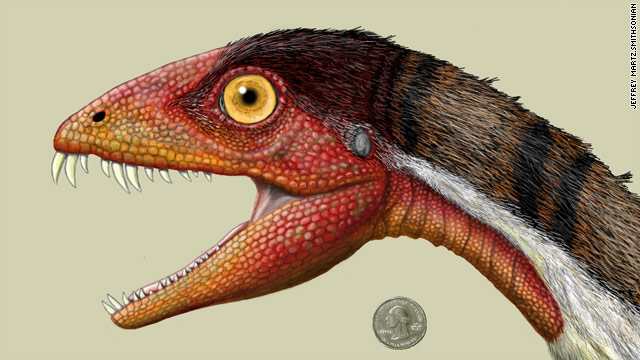
It's fitting that a place called Ghost Ranch, New Mexico, would yield the discovery of a scary-looking creature. But it's not a ghost - it's a dinosaur.
This dog-sized, ferocious-looking critter is called Daemonosaurus chauliodus, which means something along the lines of “buck-toothed evil lizard,” says Hans-Dieter Sues, lead author of the published research describing this dinosaur, and curator of vertebrate paleontology at the Smithsonian's National Museum of Natural History.
The illustration above compares the head and neck with a quarter. You can see that it has a short snout and enormous front teeth.
Scientists found the skull and neck of this previously unrecognized dinosaur, and described it in a study in the journal Proceedings of the Royal Society B.
This dinosaur provides a link between what paleontologists consider "early" and "later" dinosaurs. There's a gap in the fossil record between the oldest known dinosaurs, which walked or ran on their hind legs about 230 million years ago in Argentina and Brazil, and other predatory dinosaurs that lived much later. Daemonosaurus chauliodus helps fill in a blank in dinosaur history.
This newly discovered species lived about 205 million years ago, and probably preyed on other dinosaurs and other small animals, Sues said. At that time, what is now the American Southwest was located close to the equator, so it was warm and monsoon-like with heavy seasonal precipitation. This dinosaur was probably active during the day, although its large eyes suggest it could have seen at night as well.
How did it go extinct? It may have fallen victim to an extinction event that occurred about 200 million years ago. As the continents were separating, there was a large zone of volcanic activity. Enormous quantities of lava was released, doing "horrible things to the atmosphere." Most dinosaurs made it through (that is, until an asteroid struck around 65 million years ago), but perhaps not this one.
"It just shows that even here in the United States, there are still many new dinosaurs to be found," Sues said. "People always think we have to go to some remote places, but, right here in northern New Mexico, we can still find new dinosaurs."
__________________